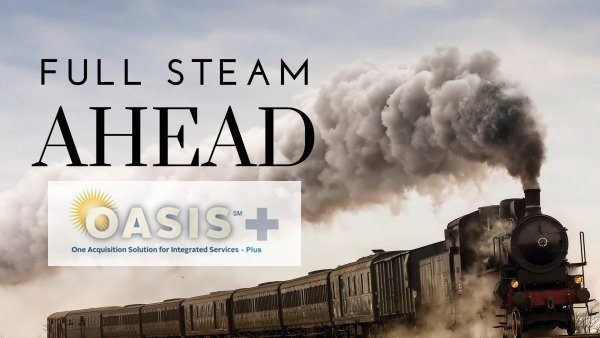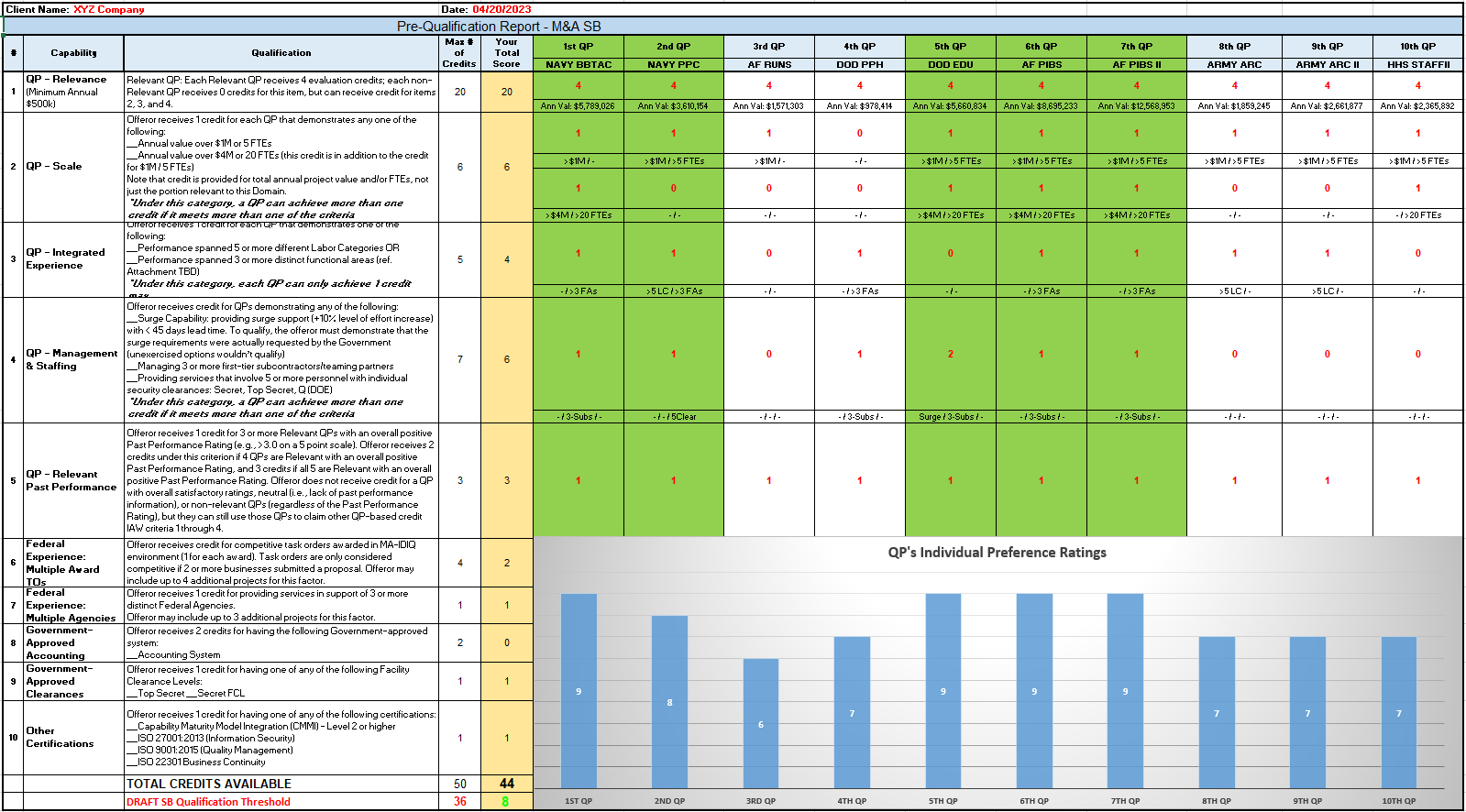.
Full Steam Ahead on the GSA OASIS Plus!
Introduction:
Some of my capture/proposal manager colleagues have told me they want to start the proposal preparation process on the $60B+ GSA OASIS Plus solicitation after the Full RFP is issued. I hope after reading this article, they change their mind. In this article, I want to show the reader why they are already way behind if they have not started yet!
Preparing a proposal for a government contract can be stressful and time-consuming, requiring a lot of effort, expertise, and attention to detail. One of the most critical factors in preparing a winning proposal is time. The earlier you start, the more time you have to prepare a well-crafted proposal. This is especially true for the upcoming OASIS Plus RFP, a self-scoring type of solicitation. Even though the Full RFP is not out yet – it was postponed three times, but the latest date is mid-June – you must complete several essential tasks in advance of the Full RFP release.
This article will discuss why you should care about these tasks, what they entail, and why you should not wait until the Full RFP drops to start your proposal preparation process. Also, note that we are nearing summer when many company staff and resources might be on vacation. You don’t want to face a situation where the RFP drops and you don’t have your best people available. And worst is that you would have to start from scratch with minimum staff.
I can think of at least four different tasks you need to undertake before the Full RFP drops, some of which are extremely time-consuming. These four main tasks are:
- Performing an Eligibility/Score Assessment
- Finding Partners (if needed)
- Chasing Incomplete Contract Documents
- Preparations for the New Pricing Section
Below I have briefly explained each of these tasks and why they are essential. I hope that once you have read through these paragraphs, you realize you should have started these tasks yesterday!
1. Performing an Eligibility/Score Assessment
As the GSA OASIS Plus is a self-scoring type of submission, the first and most important task is to perform an Eligibility/Score Assessment. This task is the cornerstone of preparing your proposal.
First, you need to decide which domains you want to go after and then establish your score for each Domain. You also must profile your contracts (see what score each brings to the table). This analytical process involves 11 to 14 variables for each of the 5 Qualifying Projects (QPs). Hence, it would be best to prepare tools to simplify and speed up the process. Preparation of the tools for your profiling and selection process is in itself a time-consuming task. Using these different tools, you must see which 5 QPs will give you the highest score.
As there is a minimum threshold of 36 points for SB submission and 42 points for the Unrestricted track, you want to ascertain that you are above that threshold. Also, it would be best to establish your weaknesses so you know what to look for if you go after partners.
To perform this assessment, you need to gather all the necessary information about your company, including your past performance, experience, and qualifications. It will help you determine your eligibility to bid on the upcoming OASIS Plus Full RFP. It is important to note that this process can take considerable time and resources, and it is best to start as soon as possible.
Sample tool used in Eligibility/Score Assessment by GDI Consulting:
2. Finding Partners (if needed)
Once you assess your maximum score, if it is below 36 for SB companies or 42 for the Unrestricted track, you need to consider bringing one or more partners to the table to increase your score. Partnering with another company can help you improve your score and make your proposal more competitive. However, if you wait until the Full RFP drops, most companies will have already found their partners, and it will be too late. The process has two aspects to it. The first aspect is establishing whether the contracts brought to the table by the partner(s) will indeed increase your score into a safe zone above the threshold. Secondly, the logistics of the business partnership itself will consume time and resources from your company, often from the highest levels. Therefore, it is essential to start looking for potential partners early on and begin the partnering process.
3. Chasing Incomplete Contract Documents
The third task is chasing incomplete contract documents. I have done over 150 self-scoring proposal preparations and seen countless cases in which the required contract documents were incomplete. I have seen this equally for large businesses as well as small businesses. As you know, you must justify the score you came up with by providing official contract documents as proof. You often face situations where you just don’t have the required document or are incomplete. For example, the contract might not have an updated CPARS or Past Performance Rating, or you are missing specific official letters that would provide justification for other subfactor scores. In other cases, contract award documents or amendments might be missing signatures and similar issues. Another situation is when your contract does not have the required NAICS/PSC for your target domain.
There are two forms accompanying the RFP, Forms J.P-3 and J.P-6. These can be used to remedy most of the above shortcomings but must be signed by the contracting officer who has issued the contract. If the contract is a federal prime contract, you must chase the contracting officer. If you are subcontracting to a Prime and using that contract, you must pursue your contract manager at the Prime company. And finally, if you are using a commercial contract, you need to chase the owner representative of that commercial company to sign off the form(s) for you. Finding these officials, briefing them and coordinating with them, and then chasing them to put that one little signature on the document is sometimes a nightmare. It can be extremely time-consuming and require a lot of follow-ups. That is why you need to start now. No, you need to have started yesterday!
4. Preparations for the New Pricing Section
The fourth and final task is preparing for the new pricing section of the proposal. Following the recent protest ruling on the GSA POLARIS solicitation, which stated that it should have included a price factor at the IDIQ level selection, GSA is amending the OASIS Plus RFP to include pricing as well. It will probably require you to provide ceiling prices for different labor categories. Therefore, you need to start working on your pricing strategy now. You should determine your labor categories, rates, and overhead costs. In these cases, they usually ask you to provide ceiling prices for when the performance of work is at your premises as well as when it is in a government facility. Starting early will give you enough time to gather all the necessary information and develop a competitive pricing strategy.
Conclusion:
Even though the OASIS Plus Full RFP is not out yet, several important tasks need to be completed in advance. These tasks include having an Eligibility/Score Assessment, partnering (if needed), chasing contract documents, and starting on pricing. It is essential to start working on these tasks early to ensure your proposal is competitive and meets all the requirements. Doing so will increase your chances of winning the contract and avoid the stress and rush that often comes with last-minute preparation. So, don’t wait for the Full RFP to drop before starting these tasks. Start now and give yourself the best chance of success. As our elders would say, the early bird gets the worm. Conversely, don’t let your and your staff’s planned summer vacation become a nightmare!


